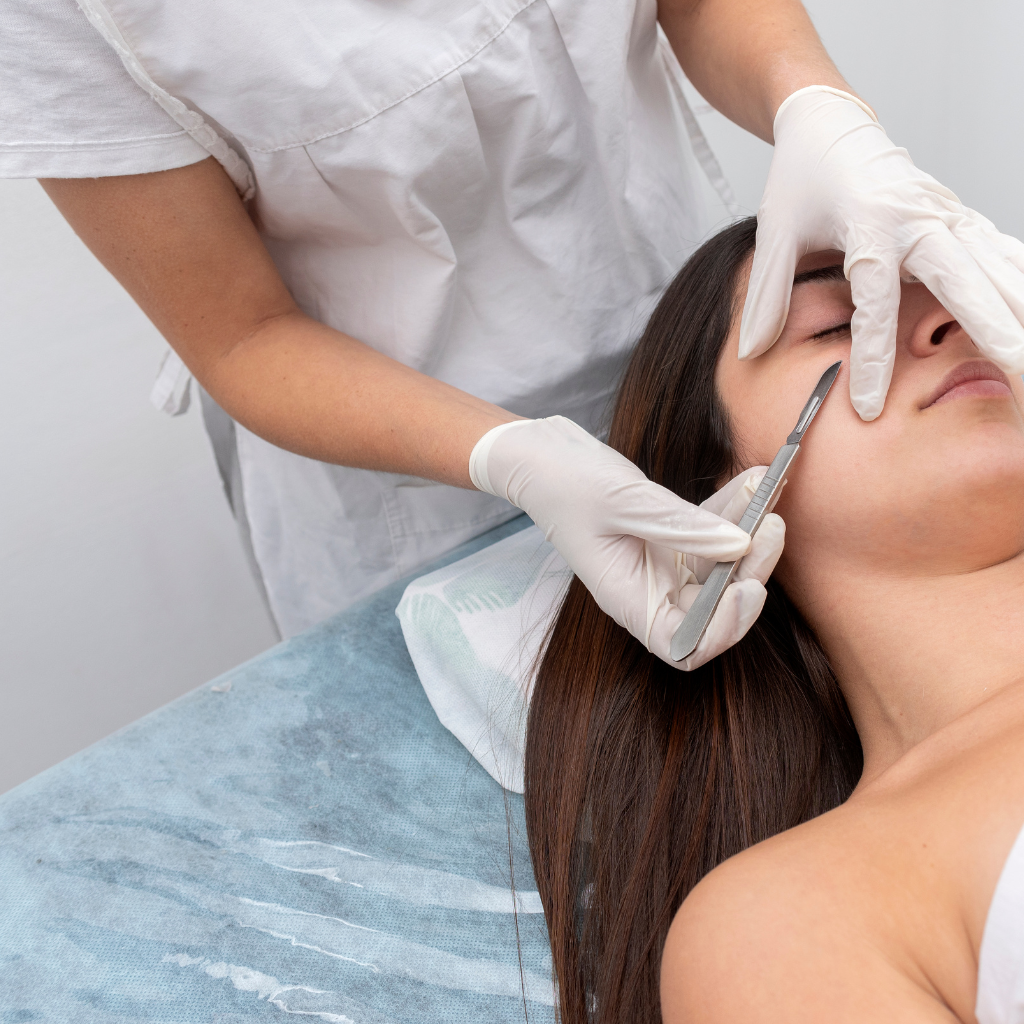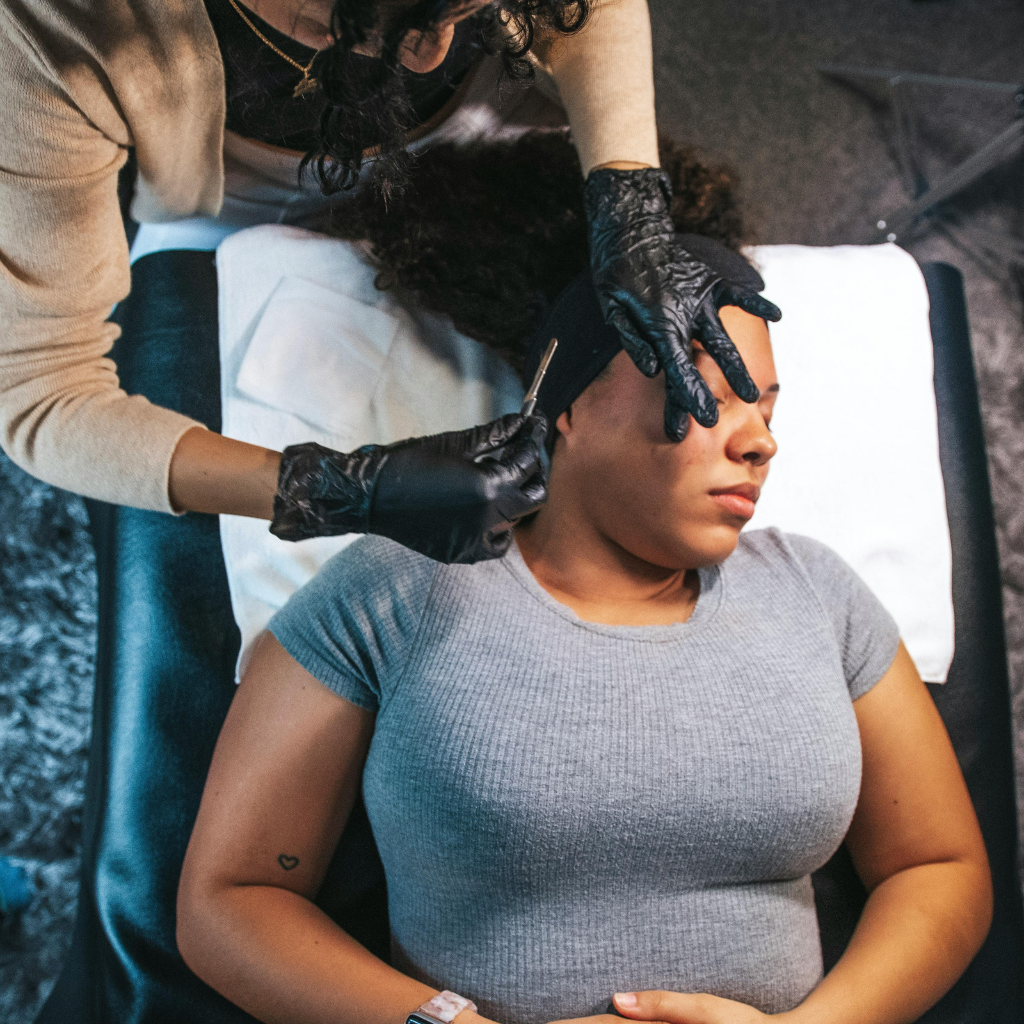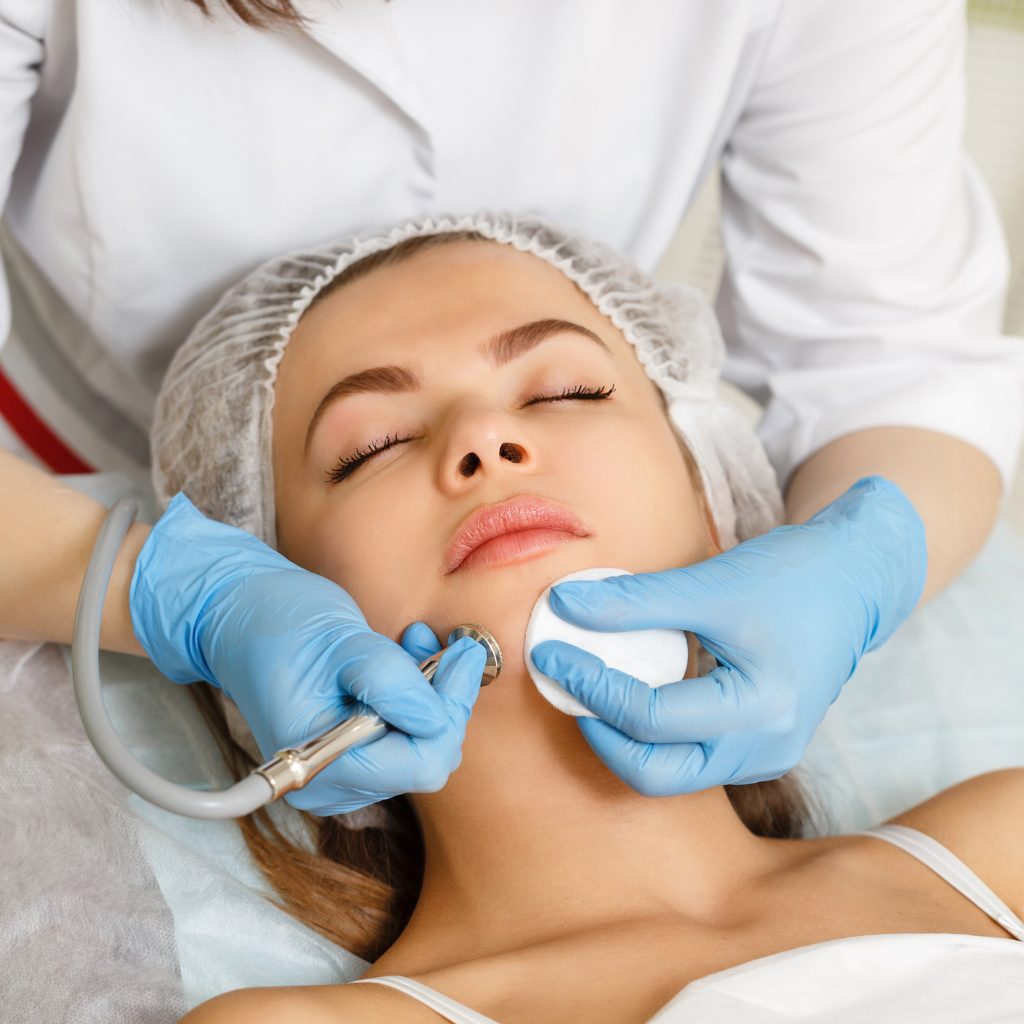How Do Dermaplaning Vs Dermabrasion Vs Microdermabrasion Differ?
- Home
- Skin Rejuvenation
- dermaplaning vs dermabrasion

Dermaplaning, dermabrasion, and microdermabrasion are skin resurfacing methods with unique techniques. Dermaplaning uses a sterile surgical scalpel for surface exfoliation, suitable for sensitive skin. Dermabrasion, an aggressive option using a rotating instrument, targets deep scars and wrinkles but may irritate sensitive skin. Microdermabrasion, employing crystals or a diamond-tipped wand, offers gentle exfoliation for uneven texture, aiding acne-prone skin. Each method varies in depth and suitability, guiding treatment choices tailored to skin type and concerns. Discovering more specifics illuminates ideal treatment pathways.
Key Takeaways
- Dermaplaning uses a scalpel for exfoliating surface acne and removing fine hair, suitable for sensitive skin.
- Microdermabrasion employs crystals or a diamond wand for gentle texture improvement, suitable for mild acne and uneven skin.
- Dermabrasion uses a rotating instrument for deep resurfacing, ideal for significant wrinkles and scars but not for sensitive skin.
- Dermaplaning and microdermabrasion are less invasive, with minimal downtime compared to the more intensive dermabrasion.
- Each method targets different skin concerns, requiring professional consultation for optimal treatment choice based on individual needs.
How does dermaplaning vs dermabrasion affect sensitive skin types?
Sensitive skin types may react differently to dermaplaning and dermabrasion due to variations in the procedures’ mechanisms.
Dermabrasion involves a more aggressive technique using a rotating instrument, which might pose a higher risk of irritation compared to the gentler, blade-based exfoliation of dermaplaning.
When considering acne-prone skin, microdermabrasion’s non-invasive approach, which uses fine crystals or a diamond-tipped wand, may offer a safer alternative with minimal risk of exacerbating breakouts.
What is the difference between microdermabrasion vs dermabrasion?
Microdermabrasion and dermabrasion are both exfoliating techniques used to rejuvenate the skin, yet they differ considerably in their approach and intensity.
Microdermabrasion employs a minimally abrasive instrument to gently exfoliate the top layer of skin, removing dead skin cells with minimal disruption. This technique is suitable for various skin types, including sensitive skin, due to its mild nature and short healing time.
Dermabrasion, however, is a more intensive procedure that uses a rotating instrument to deeply abrade the skin’s surface, targeting deeper skin concerns. This method involves greater healing time and may not be suitable for sensitive skin types, as it can cause significant irritation.
Both procedures aim to address skin concerns, but dermabrasion’s intensity may not be ideal for sensitive individuals.
Is dermaplaning vs microdermabrasion safer for acne-prone skin?
When evaluating the suitability of dermaplaning and microdermabrasion for acne-prone skin, it is crucial to take into account the specific mechanisms of each technique.
Dermaplaning is a gentle way to exfoliate the skin, using a sterile blade to exfoliate dead skin cells without irritating sensitive skin. This method is often preferred for individuals with specific skin concerns, such as active acne, as it minimizes the risk of aggravating existing lesions.
In contrast, microdermabrasion employs fine crystals or a diamond-tip wand to exfoliate the epidermis, which may be too abrasive for acne-prone skin, potentially exacerbating inflammation.
Determining which treatment is right should involve a thorough evaluation of the skin’s tolerance and sensitivity levels to guarantee ideal results.
Which Treatment Is Right for Wrinkles and Acne Concerns?
When considering treatments for fine wrinkles and acne concerns, understanding the specific mechanisms and outcomes of dermaplaning, dermabrasion, and microdermabrasion is essential.
Dermabrasion is known for its intensive exfoliation, often performed using a high-speed rotating brush that removes the outer layers of skin. This method may be more suitable for treating deeper wrinkles and significant acne scarring. In contrast, dermaplaning offers a gentler approach, using an oscillating blade that moves back and forth to carefully remove surface-level imperfections, including mild acne marks and vellus hair. Many people wonder how often can you do dermaplaning safely—it typically depends on individual skin type and tolerance but is commonly performed every 3 to 4 weeks.
Microdermabrasion, although less aggressive, can still enhance overall skin texture and tone, making it a viable option for those seeking subtle anti-aging benefits without the intensity of dermabrasion.
Should I choose dermabrasion or dermaplaning for fine wrinkles?
How does one determine the most suitable treatment between dermabrasion and dermaplaning for addressing fine wrinkles and acne concerns?
Dermabrasion involves the mechanical removal of the top layer of the skin using a rotating instrument. This technique is effective in minimizing scars and fine wrinkles, providing a smoother skin appearance.
On the other hand, dermaplaning employs an oscillating blade to gently exfoliate the epidermis, offering the benefits of dermaplaning, such as improved skin texture and tone.
When considering dermaplaning vs microdermabrasion for wrinkles, the choice often hinges on the degree of wrinkling and specific skin concerns and needs.
Dermabrasion may be preferred for deeper imperfections, whereas dermaplaning is suitable for delicate, surface-level fine lines, leaving skin looking rejuvenated.
Can microdermabrasion and dermaplaning treat mild acne marks?
Determining the appropriate treatment for fine wrinkles and acne concerns extends beyond dermabrasion and dermaplaning to include microdermabrasion.
Dermaplaning vs microdermabrasion exhibits distinct mechanisms; dermaplaning uses a sterile blade to remove the top layer of dead skin and fine hair (peach fuzz), while microdermabrasion employs fine crystals or a diamond tip to exfoliate.
Both treatments can reduce the appearance of mild acne scars by promoting skin renewal.
In dermabrasion vs dermaplaning, dermabrasion is more invasive, suitable for deeper scars. Microdermabrasion can follow dermaplaning to enhance exfoliation effects.
Acne scars and pigmentation benefit from both methods, though individual responses vary.
Each treatment holds potential for improving skin texture, demanding a tailored approach based on specific skin concerns and goals.

Does dermaplaning vs dermabrasion give better anti-aging results?
In the quest to achieve youthful skin, does dermaplaning or dermabrasion offer superior anti-aging results?
Dermaplaning involves the gentle removal of the superficial layer of dead skin and vellus hair, enhancing skin texture and promoting a smoother appearance.
Dermabrasion, on the other hand, is a more intensive procedure that removes fine wrinkles and deeper skin layers, potentially stimulating collagen and elastin production for more pronounced anti-aging effects.
When comparing these procedures, the choice depends on individual skin concerns and desired outcomes.
Microdermabrasion also offers anti-aging benefits by exfoliating the skin, though less aggressively than dermabrasion.
To determine which procedure is right, individuals should weigh the benefits: dermaplaning for a gentle approach, or dermabrasion for potentially more dramatic results.
What Are the Key Benefits of Dermaplaning and Dermabrasion?
Dermaplaning effectively enhances skin texture by meticulously removing dead skin cells and fine vellus hair, thereby promoting a smoother and more luminous complexion. It is particularly beneficial for individuals with dry skin, as it clears away surface debris that can dull the appearance.
On the other hand, dermabrasion offers significant benefits for individuals with deep wrinkles by employing a mechanical exfoliation technique that penetrates the skin’s deeper layers. During the procedure, a specialized tool moves back and forth or uses a brush to remove the top layer of skin, which triggers the skin to heal by producing fresh, healthier tissue.
Meanwhile, microdermabrasion, though not the primary focus here, is notable for its efficacy in unclogging pores, thereby contributing to improved skin clarity.
What are the top benefits of dermaplaning for dull skin texture?
While exploring the myriad techniques for skin rejuvenation, dermaplaning emerges as a prominent method for enhancing dull skin texture. This technique involves the meticulous exfoliation of the skin’s top layer, effectively removing dead skin cells and vellus hair.
By doing so, dermaplaning reveals a radiant skin appearance and fosters a smooth texture. The procedure precisely targets the accumulation of debris and superficial imperfections, contributing to an improved complexion. Its non-invasive nature makes it a safe and attractive option for those looking to refresh and enhance their skincare routine.
Through the mechanical action of a sterile blade, dermaplaning enhances the skin’s ability to absorb topical treatments, thereby optimizing the efficacy of subsequent skincare products. This results in a more luminous and rejuvenated skin surface.
Why are the benefits of dermabrasion ideal for deep wrinkles?
As one explores further into skin rejuvenation techniques, dermabrasion stands out as an effective method for addressing deep wrinkles. Dermabrasion is a procedure utilizing a high-speed rotating brush to meticulously remove layers of dead skin, promoting healing and regeneration. This method minimizes scars on the skin and is particularly advantageous for deep wrinkles, offering a more profound result compared to dermaplaning vs microdermabrasion for acne. The back-and-forth motion to evenly abrade the skin surface facilitates ideal outcomes.
| Technique | Target Area | Key Benefit |
|---|---|---|
| Dermaplaning | Surface acne | Smooths texture |
| Microdermabrasion | Superficial scars | Exfoliates outer layers |
| Dermabrasion | Deep wrinkles | Reduces wrinkle depth |
Dermabrasion offers benefits such as smoother skin texture and diminished appearance of wrinkles.
What benefits does microdermabrasion offer for clogged pores?
Microdermabrasion offers several key benefits for addressing clogged pores, making it a popular choice for those seeking clearer skin.
This technique employs a speed-rotating brush to remove the outermost small areas of skin, effectively exfoliating dead cells and superficial debris that contribute to clogged pores. As a result, it promotes the emergence of new skin, enhancing overall skin tone and texture.
When considering microdermabrasion vs dermaplaning, both methods aim to rejuvenate the skin, though dermaplaning removes vellus hair and dead skin cells manually. The best option for you depends on your skin’s specific needs.
Microdermabrasion is particularly adept at treating clogged pores by improving skin clarity and facilitating better absorption of skincare products, offering a practical solution for maintaining healthy skin.
What Are the Differences Between Dermaplaning and Microdermabrasion?
Dermaplaning and microdermabrasion are both exfoliative procedures aimed at enhancing skin texture, yet they employ different mechanisms to achieve their effects.
Dermaplaning, like other manual exfoliation methods, uses a sterile surgical scalpel to gently remove the stratum corneum and fine vellus hair, making your skin look smoother and more radiant. In contrast, let’s compare microdermabrasion, which utilizes fine crystals or a diamond-tipped wand to abrade the skin’s surface mechanically.
Though both treatments can be effective individually, their simultaneous application requires careful consideration to guarantee safety and optimize results. The choice between them often depends on your specific skin concerns and desired outcome.
It’s worth noting that dermabrasion involves the surgeon using a more aggressive technique than either dermaplaning or microdermabrasion, making it more suitable for treating deeper scars and significant skin irregularities.
Is dermaplaning vs microdermabrasion better for smooth skin texture?
When evaluating the efficacy of dermaplaning versus microdermabrasion for achieving a smoother skin texture, it is essential to understand their fundamental differences.
Dermaplaning involves the mechanical exfoliation of the skin’s outer layer using a sterile blade to remove dead skin cells and fine vellus hair, making it a good option for those with dry or sensitive skin. This method often results in minimal redness and enhances skin smoothness, targeting dark spots effectively.
In contrast, microdermabrasion employs abrasive crystals or a diamond-tipped wand to exfoliate the skin while stimulating collagen production. While it is also effective for improving skin texture, it may not be suitable for sensitive skin due to potential irritation.
Consequently, selecting the appropriate treatment depends on individual skin type and concerns.

Can dermaplaning and microdermabrasion be done together safely?
Evaluating the compatibility of dermaplaning and microdermabrasion performed concurrently necessitates a clear understanding of the distinct mechanisms and effects of each procedure.
Dermaplaning involves a precise scraping technique to remove dead skin cells and fine vellus hair, whereas microdermabrasion also exfoliates the skin using fine crystals or a diamond-tipped wand.
Combining these methods offers enhanced exfoliation but requires careful consideration due to potential irritation, especially for sensitive skin.
To safely integrate both treatments:
- Schedule an appointment with a licensed professional to determine if dual procedures are right for your skin.
- To protect your skin, consider trying dermaplaning first to assess tolerance.
- Follow with microdermabrasion if the skin reacts positively.
- Use a high SPF sunscreen post-treatment.
This approach gives better results for those with robust skin types.
How to Decide Between Dermabrasion or Dermaplaning Treatments?
When deciding between dermabrasion and dermaplaning treatments, it is essential to assess the individual’s skin type, desired outcomes, and any existing skin conditions.
Dermabrasion, an intensive exfoliation method often performed using a device called a dermatome, is more suitable for addressing deep scars or significant textural issues. On the other hand, dermaplaning may be preferred for those seeking a gentler procedure that targets surface debris and fine vellus hair.
Dermaplaning can be performed regularly as part of a skincare routine and naturally keeps your skin looking smoother and brighter over time.
A consultation with a qualified dermatologist can offer tailored advice and recommendations based on these factors and any contraindications.
Which treatment is right: dermabrasion or dermaplaning?
Selecting the appropriate skin treatment between dermabrasion and dermaplaning hinges on understanding their distinct mechanisms, benefits, and suitable skin types.
Dermabrasion or dermaplaning? The differences between dermaplaning and dermabrasion are notable. Dermaplaning, similar to shaving, uses a razor and has an oscillating motion to remove fine layers of skin, making it ideal for surface-level exfoliation.
Dermabrasion, however, addresses irregularities in skin texture and hyperpigmentation by abrading deeper layers.
- Dermaplaning can be done on sensitive skin.
- Dermabrasion is suitable for addressing the size and depth of scars.
- Dermaplaning also targets vellus hair removal.
- Skin is sensitive post-dermabrasion, requiring significant aftercare.
- Dermaplaning vs microdermabrasion: They differ in intensity and depth of treatment.
Choosing between treatments involves evaluating individual skin needs and desired outcomes.
How do I choose between microdermabrasion and dermaplaning?
Determining the ideal treatment between microdermabrasion and dermaplaning requires a thorough understanding of each procedure’s mechanism, benefits, and limitations. Microdermabrasion utilizes a diamond-tipped brush to exfoliate the top layer of skin, promoting cellular regeneration. In contrast, dermaplaning employs an oscillating blade to remove dead skin cells and vellus hair, optimizing skin texture. Each method caters to specific needs, with microdermabrasion being effective for rough skin and dermaplaning targeting fine hair removal.
| Treatment | Mechanism | Best For |
|---|---|---|
| Microdermabrasion | Diamond-tipped brush exfoliation | Uneven skin texture |
| Dermaplaning | Oscillating blade | Removing fine facial hair |
| Diamond Microdermabrasion | Enhanced exfoliation | Advanced skin resurfacing |
Evaluating individual skin concerns and desired outcomes guarantees the selection of an appropriate treatment.
Conclusion
In summary, dermaplaning, dermabrasion, and microdermabrasion each offer distinct benefits and considerations for different skin types and concerns. Dermaplaning is ideal for those with sensitive skin seeking exfoliation without irritation. Dermabrasion provides deeper treatment suitable for addressing significant wrinkles and acne scars, while microdermabrasion offers a gentler option for similar concerns. Evaluating individual skin type, specific concerns, and desired outcomes is essential in selecting the appropriate treatment, ensuring best results with minimal adverse effects.

Highly skilled cosmetologist at Tune Clinical Aesthetics, specializing in advanced skin and hair treatments.





